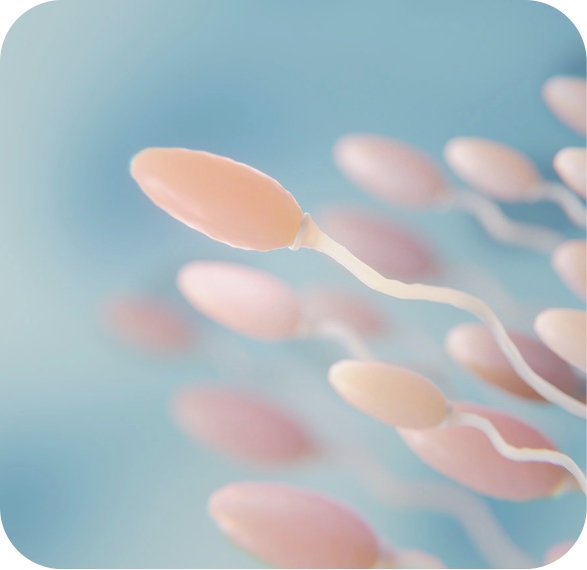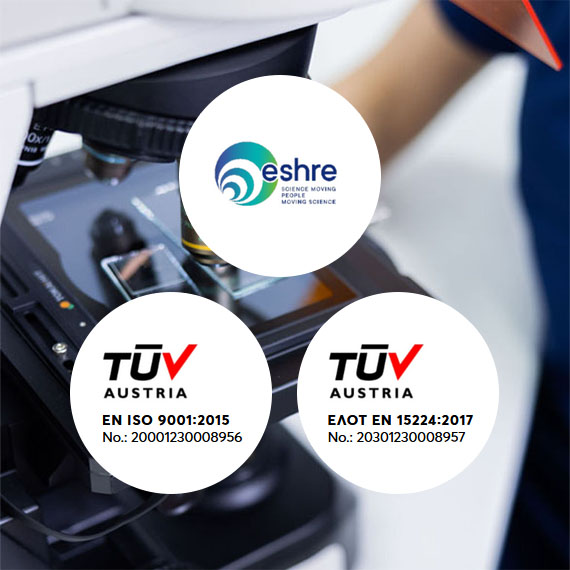What is a spermiogram?
A basic test for evaluating the fertilizing capacity of sperm and the function of the accessory glands of the male reproductive system, such as the seminal vesicles and the prostate.

of abstinence
Ποια είναι η προετοιμασία για το σπερμοδιάγραμμα;
The only preparation required is to abstain from ejaculation for three (3) to five (5) days (not less than two (2) days and not more than seven (7) days). Additionally, the man should not feel tired or exhausted. It should also be noted that there should not have been a high fever in the last 2.5 months, as it may negatively affect sperm production.
What are the normal values?
According to the new WHO 2021 criteria, the reference values are:
PARAMETER | REFERENCE VALUE |
|---|---|
Liquefaction time | < 30 minutes |
pH | ≥ 7,2 |
Semen volume | > 1,4 ml |
Sperm concentration (sperm count/ml) | > 16×106/ml |
Total sperm count | > 39×106 |
Total progressive (rapidly progressive+slowly progressive) | > 30% |
Total motile (rapidly progressive+slowly progressive+non-progressive) | > 42% |
Vitality | > 54% |
Morphology | ≥ 4% |
In Greece alone, it's estimated that over 350,000 couples are affected by fertility issues each year.
A normal spermiogram cannot guarantee conception, and conversely, an abnormal spermiogram does not exclude the possibility of achieving pregnancy. The distinction between normal and abnormal spermiogram is related to increased or decreased probabilities of achieving conception.
Do you have more questions?
Contact us, and one of our fertility experts will answer all your inquiries.
It’s normal for semen samples to show fluctuations in both quantity and quality. The WHO recommends performing the test two or three times to ensure reliable results. Typically, a normal spermiogram, according to WHO criteria, rules out serious fertility issues, while abnormal findings warrant further investigation.
The timing for repeating a spermiogram depends on the reason for the follow-up. If the goal is to rule out potential issues or observe natural fluctuations in sperm within the same spermatogenesis cycle, it can be repeated after 1-2 weeks or up to 2 months from the initial test. However, if the purpose is to assess the impact of a treatment or medication, the test should be repeated after at least 75 days, which corresponds to the next spermatogenesis cycle.
The test must necessarily be performed again because there is a normal fluctuation in the various parameters each time a man provides a sample. If the second result also does not meet the minimum normal limits, further investigation is required to determine the causes of infertility. Visiting a specialized urologist and/or endocrinologist in these cases is essential. After taking a thorough medical history, the doctor will proceed with a clinical examination and provide instructions for more specialized tests, such as semen culture, hormonal tests, biochemical tests of semen, testicular ultrasound, search for antisperm antibodies, DNA fragmentation (DFI), chromosomal and genetic testing, among others.

Diagnosis of Infertility VS Prediction of Fertility
The spermiogram can diagnose infertility, but it cannot predict fertility. This is because, on the one hand, normal sperm may exhibit other disorders (e.g., increased DNA Fragmentation Index (DFI)), and on the other hand, fertility also depends on female factors. Therefore, predicting fertility depends not only on the spermiogram but also on other diagnostic tests of both the man and the woman. Infertility, by definition, is a problem of the couple and not of each individual separately, and the severity of the problem arises from the combination of each partner's fertility.
Infertility concerns the couple, and therefore it should be addressed with the proper collaboration of the gynecologist, urologist, and endocrinologist, based on the diagnostic test results of both partners.
Who should have a spermiogram?
A spermiogram can be beneficial for any man who wants to know about his fertility.
Additionally, it should be performed upon a clinical doctor’s recommendation in the following situations:
- Men planning to have children: Those undergoing fertility assessment with their partner.
- Men of infertile couples: Those entering assisted reproduction processes to determine the most suitable treatment, such as intrauterine insemination, conventional in vitro fertilization (IVF), or intracytoplasmic sperm injection (ICSI).
- Investigating reproductive system function: When assessing the function of accessory glands of the reproductive system, such as in cases of inflammation or haematospermia.
- Suspected testicular function disorders: When clinical signs or history suggest conditions like varicocele, cryptorchidism, viral infections, testicular trauma, or torsion.
- Pre-surgical or therapeutic procedures: Men about to undergo treatments or surgeries that may impact testicular function – in fact in these cases sperm cryopreservation for future use should be considered.
- Post-vasectomy confirmation: Men who need to confirm the absence of spermatozoa in the semen after a vasectomy.
It should be emphasized that the earlier a problem is diagnosed, the more effective its management by the clinical doctor is.
Why do a spermiogram at Spermogene?


Our comprehensive report translates your test results into clear insights about your fertility and future plans.


We provide tailored advice based on your individual habits and lifestyle, offering strategies to maintain or even enhance your fertility.


Enjoy direct access to our highly trained fertility specialists for a thorough discussion of your results and potential next steps.


We adhere to international certification standards and engage in rigorous internal and external quality controls.

9001:2015
15224:2017
How is it performed?
The analysis is carried out through microscopic observation by specialized and experienced scientists, rather than using automated analyzers. All parameters are evaluated according to the strict standards of the World Health Organization (WHO 2021). We participate in the ESHRE-SIGA external quality control system and implement a Quality Assurance System ISO 9001:2015 & ΕΛΟΤ EN 15224:2017, certified by TUV AUSTRIA HELLAS, ensuring accurate results.